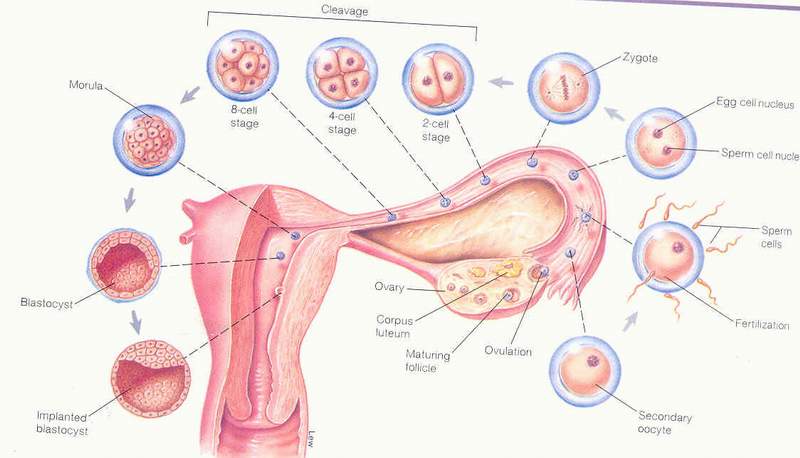
Once an egg is fertilized by a sperm, it becomes a diploid zygote. The zygote will divide by mitosis several times over the next 3 days to become a solid mass of cells called a morula. Over the next 7 days, the morula keeps on dividing to become a hollow ball called a blastula. It takes about 10 days for the blastula to implant into the uterus which is rich in nutrients from a thick coat of blood.

Some cells of the blastula become the placenta which wraps around the embryo. Some cells become the chorion and the umbilical cord. The rest of the cells will develop into an infant.




In some pregnancies, twins may develop. Fraternal twins occurs when the ovaries release 2 eggs at the same time and they both become fertilized. Identical twins are from the same zygote that split in 2. The 2 pieces of the zygote develop independantly.
Endoderm = Innermost layer. Lines organs and makes certain glands.
Mesoderm = Middle layer. Forms bones, muscles, circulatory system.
Ectoderm = Outermost layer. Forms epidermis, cephalic bones, muscles, eye, nasal cavity, and brain.
Histogenesis = The germ layers forming tissues.
Organogenesis = The germ layers forming organs.
Labor occurs in 3 stages
 In the first stage of labor the uterus begins contracting and the cervix dilates.
In the first stage of labor the uterus begins contracting and the cervix dilates.
 In the second stage of labor,
the fetus descends down into the birth canal. When crowning occurs, the fetus can be pushed out. However, the cervix must be dilated to 10cm. Tearing could occur is pushing begins earlier.
In the second stage of labor,
the fetus descends down into the birth canal. When crowning occurs, the fetus can be pushed out. However, the cervix must be dilated to 10cm. Tearing could occur is pushing begins earlier.


In the third stage of labor, the placenta needs to exit the womb.
Some mothers choose to preserve the infant's umbilical cord by freezing it. Stem cells are present in the cord and can later be used to duplicate organs or tissue that may be needed in the future.
Fetal alcohol syndrome results when a mother consumes alcohol during her pregnancy. Distinct physical charateristics and mental retardation result.
Every human sperm cell has 23 chromosomes and every human ovum has 23 chromosomes. The process of meiosis regulates the separation of chromosomes.
Traits from both parents combine and are expressed (shown). Genes carry these traits which may be common in a population (dominant) or rare in a population (recessive). By following a personís family history of traits, many traits can be assigned as dominant or recessive.
In every individual, 2 alleles are assigned for every trait. One letter of the alphabet is designated. These alleles can either be heterozygous (different) Aa ; homozygous (same) AA or aa. If the alleles of 2 parents are known, then predictions can be made about their children. By making a punnett square, one can see the probability of what traits their child will have.